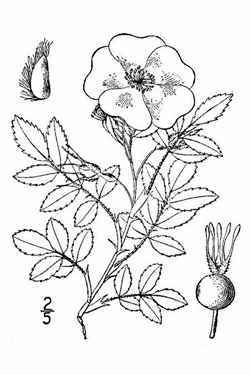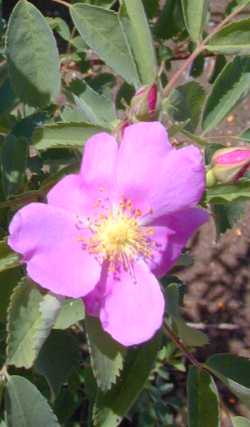USDA: 4-9
Sun Exposure: Moderate shade to full sun
Origin: Northern America: Minnesota west and northwest to Alaska and British Columbia, south to Arizona, northern Mexico and western Texas and north to western Kansas and North Dakota along rivers and creeks
Growth Habits: Long-lived perennial bushy shrub, up to 5 feet tall (1.5 m)
Propagation: Hardwood cuttings, seeds

Britton, N.L., and A. Brown. 1913. Illustrated flora of the northern states and Canada. Vol. 2: 284.
The Wood's Rose is one of the most frequent native rose in northern America. Native americans made extensive use of Wood's rose roots, stems, leaves, flowers, and hips for foods and therapeutic materials. The hips are a source of vitamin C and are dried for use in flavoring teas, jellies, fruitcakes, and puddings. The flowers provide a source of pollen for honey bees. Wood's rose is used as an ornamental near homes to attract birds and other wildlife.
Blooming Habits:
Rosa woodsii blooms from late spring to early summer. The flowers are strongly scented, around 2 inches across (5 cm), with 5 petals. The rose hips stay on the plant until winter.
Culture:
The Wood's Rose is susceptible to various leaf spots, as well as to leaf rusts, gray mold, powdery mildew, common gall, and stem cankers.
Desert-Tropicals is dedicated to provide gardening advice, gardening ideas, and information about flower of all kind for landscape and collections.We try to check carefully the identification of the plants on the illustrations as well as the other information from the page, but occasionally errors do occur. if you notice anything that needs to be changed please contact us.Thanks.
© 1998-2020 Philippe Faucon, All Rights Reserved.
